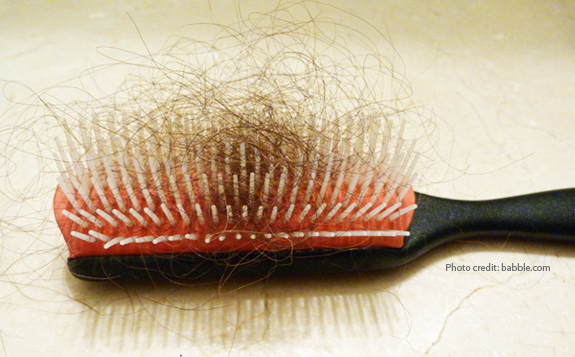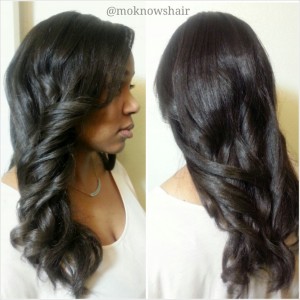
On average, a healthy person sheds 50 to 100 strands of hair per day. If you notice that parts of your hair are thinner than others, or you feel too much of your hair ends up in your brush and on the bathroom floor every time you style your hair, you may have something more serious than normal shedding.
Now, don’t “Web MD” this and diagnose yourself with a condition you may not have (lol), but at least consider seeing a doctor if you are experiencing the symptoms described in these common conditions associated with excessive shedding and hair loss:
Androgenetic Alopecia is a genetic form of hair loss and is the most common according to the American Academy of Dermatology. Nearly 80 million men and women in the U.S. experience this type of hair loss. There is also an autoimmune disorder called Alopecia Areata that causes the immune system to attack hair follicles causing noticeable bald spots. There are tests available to diagnose this condition and in most cases, it is treatable with prescribed medication from a dermatologist.
Telogen Effluvium (TE) is the second most common hair loss disease that dermatologists see and it mainly occurs after pregnancy, major surgery or after periods of extreme stress. With this type of hair loss you shed large amounts of hair every day due to a change in the number of hair follicles growing hair. Since you shed 50-100 strands a day on average, if new ones are not growing to replace them, you experience visible hair loss. TE can also be a side effect of certain medications, such as antidepressants, beta-blockers, and non-steroidal anti-inflammatory drugs. While there are no specific tests available, a dermatologist may be able to diagnose you based on an exam. If it is indeed a medication causing the problem, ask your doctor about an alternative or lower dosage. If it is stress, find ways to reduce it or seek the help of a professional therapist or life coach for a plan of action.
Thyroid disease affects millions of people, especially women (so you need to have it checked!). Your thyroid is responsible for the rate at which your body grows hair, skin and nails. If your thyroid is underactive (Hypothyroidism), you may experience excessive weight gain, depression, brittle nails and shedding hair. A simple blood test at your doctor’s office can determine if your thyroid is functioning properly and there are medications that can be prescribed to you to restore it to normal levels if necessary.
Lupus is an autoimmune disease that causes your immune system to attack healthy tissue. You will feel extremely fatigued and have frequent headaches with this disease. You will also have painful, swollen joints, and many people experience hair loss as an early symptom (singer and actress Toni Braxton is diagnosed with this disease). A rheumatologist can run blood tests and do other examinations to determine if you have Lupus. This disease is treated with medication and if you are experiencing rashes on the scalp, a dermatologist can prescribe a topical cream to you.
Iron deficiency occurs when you do not have enough red blood cells to transport oxygen throughout your body to give you energy. Anemia is the disease associated with this deficiency and often causes extreme fatigue, pale skin, cold hands and feet and hair loss. Your doctor can test your blood to diagnose this and taking iron supplements along with eating iron-rich foods can treat this condition.

Beyond diseases and conditions that can cause excessive shedding, you could be the reason behind your hair loss.
- Bleaching or dying your hair too often or over-processing can cause your hair to slowly shed over time or fall out in large amounts, very quickly. (See what you need to know before deciding to dye your hair.)
- Excessive heat styling and exposure to dry external elements (cotton pillowcases, wool scarves and hats, extremely dry climates) can dry your hair and make it vulnerable to breakage and shedding. (See how to use heat protectants to prevent damage.)
- If you are not drinking enough water and eating enough protein, you may not be stimulating new hair growth. Alternatively, if you are using protein treatments too often, your hair can become dry and brittle and start to shed.
- You may be over doing it on the “protective” styling. Too much of any good thing can be bad. All the pulling and tugging on your hair can weaken it over time causing shedding and breakage following long stints in “protective” styles (mainly sew-ins and extension braiding).
- You hair may be too dry. Moisture is essential, and the best way to install it is through deep conditioning. Look for treatment masks that claim to have “intense hydration,” use sulfate-free shampoos and always wash and rinse your hair in cool water to seal in moisture.
- Your brushes are snagging your hair and pulling it out. You need to replace your brushes every six months, especially if you are using boar bristled brushes. The bristles split with natural wear-and-tear and will cause your hair to catch and snag.
There are lots of other reasons you could be experiencing shedding not mentioned here. Because everyone’s hair is different, there are many possibilities for what can cause extreme damage. If you see spots in your scalp that seem to not be covered by hair or you find several dry patches or red sores, do not ignore this and assume covering it in oil will work. Or, if you feel your hair is shedding more than usual, meaning you end up with big, hand-sized hair balls with each wash or style, make an appointment with your doctor to discuss your hair loss and see if you need to be tested.

I was wondering what color is in your hair, and what coloring products do you recommend?
@Kay Hair Dye Basics and Demi-Permanent Dye Application: http://youtu.be/-HG_xpi1AcM
This is a video from her channel on YouTube. She goes through everything step by step 🙂